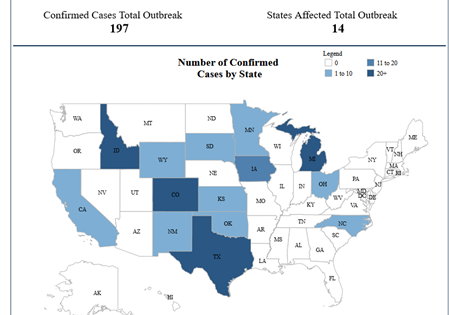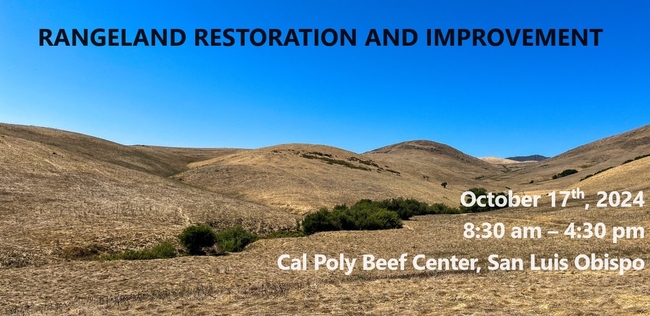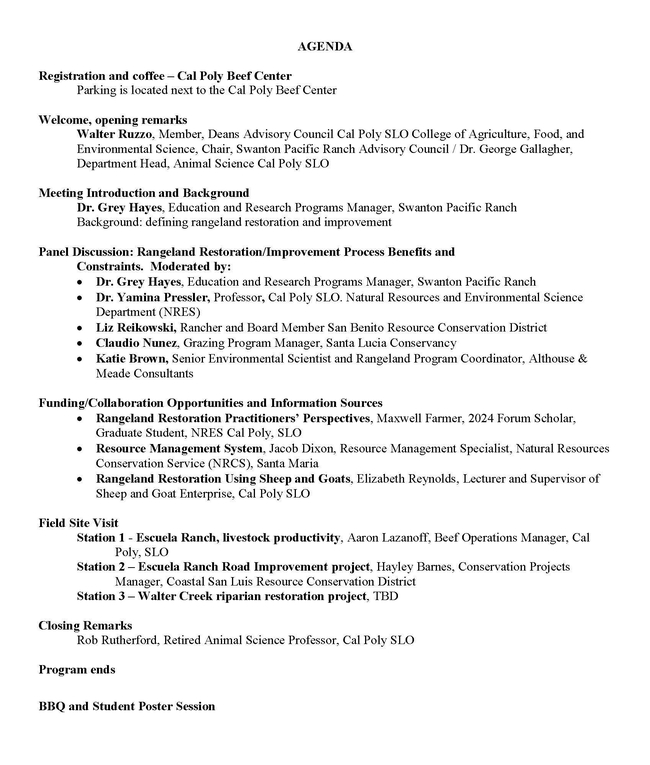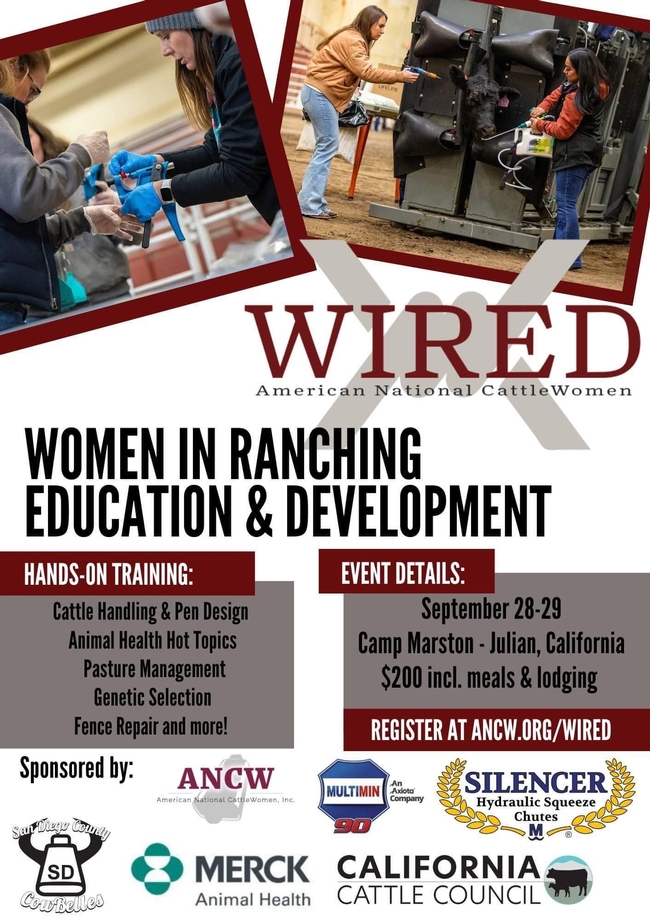- Author: Devii R Rao
Please join the San Benito Weed Management Area for our 23rd annual Continuing Education Seminar for Ranchers. There will be talks on laws and regs, weed management in State Parks, biological weed control, how to calibrate a sprayer, ground squirrels, and weeds that are to livestock, including hearing from our local vet about how those toxic weeds affect livestock and what you can do.
Date: Tuesday, December 3, 2024
Time: 8:00 am to 1:00 pm
Location: Hollister Veterans Memorial Building
649 San Benito Street, Hollister
Cost: Free
CEUs: The Department of Pesticide Regulation (DPR) has approved 3 hours of pesticide continuing education credit (including 1 hour of laws and regulations)
Click here for the agenda.
2024 Ranchers Flyer
- Author: Devii R Rao
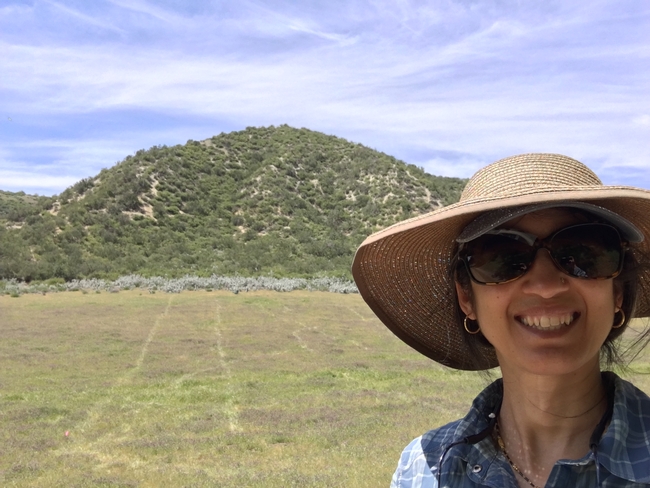
I will be transferring to the Livestock and Natural Resources Advisor position in Sonoma and Marin counties. I will still be working for UCCE and in the same role, just a different location. I was born and raised in Marin County and my family is still there. So this is an opportunity for me to continue doing the kind of work I love, and to do it closer to my family.
My new position will start January 1, 2025. I will continue working in the Hollister office through December 11 and will take the last few weeks of December off to move. UC is planning to re-fill my position on the Central Coast, hopefully within a year. So, you won't be without an Adviosr for too long. Once the new Advisor starts, I will come down to help get them started and introduce them to some local folks.
I will continue to have the same email address after I move (drorao@ucanr.edu), so please feel free to reach out to me after I move, especially if you are heading up to the North Bay! I'd love to see you!
- Author: Gabriele U Maier
Dr. Gabriele Maier, Professor of Extension, Beef Cattle Herd Health and Production, UC Davis
September 2024
What happened? The California Department of Food and Agriculture (CDFA) announced in a press release on August 30th, 2024 that highly pathogenic avian influenza (HPAI) was detected in three dairies in the Central Valley. The outbreak of this flu virus in dairy cattle was first reported in the Texas panhandle in the spring of this year after several dairy herds had cows become sick with an unidentified illness. The affected cows were lethargic, had a fever, some had clear nasal discharge, diarrhea or dry feces, dropped in feed consumption and milk production, and most remarkably shed thick, colostrum-like milk. Most of the affected cows recovered after a couple of weeks, but their milk production did not reach the same levels as before they became ill. Veterinarians were unable to determine the cause of these outbreaks for some time, but dead birds on the dairies and cats with neurological signs finally raised the suspicion for avian flu. Cats and other mammals often become neurological when infected with HPAI and cats on dairies become infected when drinking raw milk. Samples collected from affected cows indeed came back positive for HPAI and since then, dairy herds in multiple states across the U.S. have tested positive for the virus. For a current and historical overview of affected states go to the United States Department of Agriculture (USDA) dashboard. As of September 3rd, 2024, a total of 14 states have diagnosed cases in 197 herds.
How did this virus get into dairy cattle? It is now believed that the virus spilled over from birds to dairy cattle in a single event, i.e. one cow was infected in Texas through bird droppings or a dead bird, and the virus has since spread from cow to cow only. Flu viruses change often, which is why we need a new flu vaccine in people every year. When a host such as a bird gets infected with two types of flu viruses at the same time, the viruses can reassort their genetic material. By random chance events, the newly assorted virus is now capable of infecting a new host, in this case cattle.
How has the virus spread between cattle so quickly? HPAI is shed in large numbers in the milk, even before cows show clinical signs of disease. It is very likely that the virus spreads between cows on a dairy through milking machines. The virus is also shed in small amounts in urine, nasal secretions, and saliva. In a study where dairy heifers were experimentally exposed to the virus via an inhalation mask, heifers only had a temporary increase in nasal discharge without any other clinical signs. However, the same researchers infected the udder of lactating cows experimentally through the teat canal and were able to reproduce the same disease symptoms seen on the affected dairies: abnormal milk, decreased feed intake, watery diarrhea or dry feces, a significant drop in milk production and clear nasal discharge. A preliminary version of this study is available online. Even though there are quarantines and movement restrictions in place for herds where HPAI is found, the rapid spread of the disease shows how interconnected the cattle industry is and how fast and far pathogens can travel. The virus has also been spread from cows to domestic poultry, which are susceptible to HPAI. When HPAI is found in domestic poultry, the typical outcome is that all birds are euthanized. For all these reasons, biosecurity is of utmost importance to curb the spread of HPAI among cattle and poultry.
Is there a risk to people? So far, only a few cases of avian influenza have been reported in dairy workers, none in California yet, and all have had mild symptoms and have recovered. Humans luckily do not appear to be the main target species of this type of avian flu virus even when directly exposed to infected cows, but personal protective equipment (PPE) is highly recommended for those working on dairies. Human safety is paramount, and the USDA offers financial support for affected premises to purchase PPE, such as gloves, goggles, and masks for farm workers. Early on, it was also determined that pasteurization inactivates HPAI virus, so the milk supply stays safe. The USDA is also confident that the meat supply is safe and will be adding H5N1 monitoring in dairy cows at slaughter to its program later in September. It is, however, not recommended for people to consume raw milk as milk appears to be the main vehicle for transmission and may not be safe to drink.
What happens now in California? The staff at the Animal Health branch at CDFA had been preparing for the moment when HPAI would be detected in a California dairy herd. Factsheets and regulations are posted on a dedicated website. Lactating dairy cattle moving interstate from California require a Certificate of Veterinary Inspection and a negative HPAI test within seven days of movement. All dairies are urged to increase their biosecurity including cleaning and disinfection of vehicles to transport cattle, restriction of worker movement between dairies and poultry facilities, limiting visitor access to premises, wild bird deterrence, etc. All lactating cattle shown at fairs must have a negative PCR test for the virus from a milk sample within seven days before arriving at the fair. Enhanced biosecurity for dairy cattle at fairs has also been outlined in a factsheet.
Is there a vaccine? There is no vaccine for cattle yet, but several pharmaceutical companies are working on the development of such vaccines. The USDA is also conducting research into a vaccine. If or when a vaccine for cattle will become available is still unknown today, but the flurry of activity is a promising sign.
What do beef ranchers need to consider? No beef cattle have been found to be infected with HPAI to date. Spread within a beef herd would likely be limited because cows aren't being milked. However, beef cows are likely not immune to the virus. Therefore, biosecurity should also be on ranchers' minds, especially for those who have contact with dairy cattle or domestic poultry. You do not want to become a fomite. The biosecurity training provided by the Beef Quality Assurance program is a good starting point to learn how to prevent spread between cattle or between cattle and poultry. Chapter 3 in the BQA manual is full of good information. For example, a trailer that is used to transport cattle from multiple herds should be thoroughly cleaned and disinfected between loads. Changing clothes and washing boots between visiting different herds should also be practiced. Limiting visitors to the ranch and keeping a visitor log is also encouraged.
The avian influenza outbreak in California dairy cattle is a stark reminder of the unpredictable nature of viral diseases and their ability to cross species barriers. It is important to follow the science, listen to guidance from experts, understand that sometimes things change, and we need to adapt with the change. We have successfully overcome Covid19 – we will also get through avian flu in dairy cows. Keep checking the CDFA website to stay informed on the development of this new cattle disease.
- Author: Devii R Rao
Join UC Cooperative Extension and Cal Poly for the Central Coast Rangeland Coalition Fall Workshop
Date/Time: Thursday, October 17, 2024, 8:30 am – 4:30 pm
Location: Cal Poly Beef Center Pennington Road, San Luis Obispo, CA 93405
Cost: $40.00 – lunch included
Rangeland Restoration and Improvement: what it is and how it can meet your land management needs
Restoration and improvement plays an important role in the management of rangeland systems and consists of many different complex ecological and social processes. Exploring the restoration and improvement process with its associated social aspects like funding and collaboration opportunities is imperative for assuring the future health of rangelands on the central coast of California.
Goal: Increase practitioner's understanding about the process of restoring/improving rangeland systems, including the benefits and steps involved, project feasibility, and collaboration and funding opportunities.
Registration Link: https://ucanr.edu/ccrc%20fall%202024


